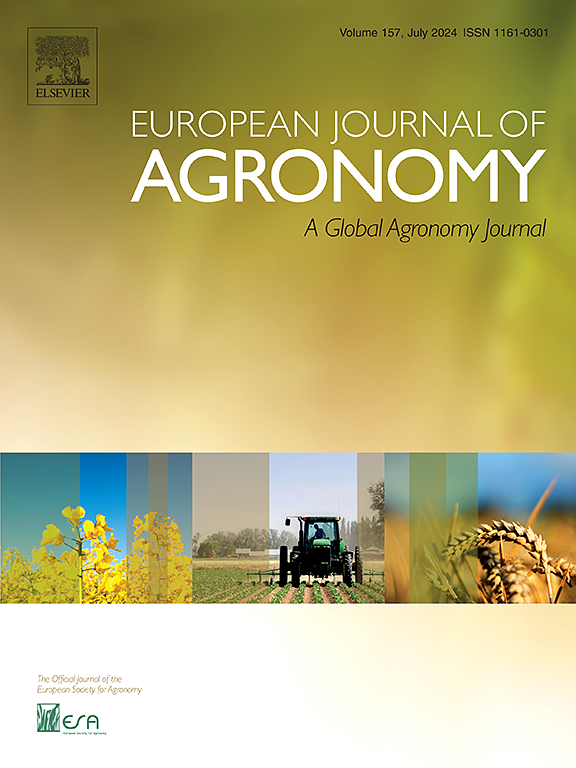从水量投入到收获指数,了解中国黄土高原旱地玉米塑料地膜的粮食增产和用水效率
IF 4.5
1区 农林科学
Q1 AGRONOMY
引用次数: 0
摘要
在中国黄土高原,塑料地膜(PM)是旱地玉米(Zea mays L.)在限水条件下提高籽粒产量(GY)和水分利用效率(WUE)的有效农艺措施。然而,关于 PM 如何逐步影响田间用水,进而提高 GY 和 WUE 的定量数据却十分匮乏。本研究旨在确定在田间用水途径中哪些变化产生了可吸入颗粒物对生长总重和水分利用效率的积极影响。在无性系初期(EVS)、无性系后期(LVS)、生殖期(RS)和整个生长季(GS)期间,田间水分利用途径分为五个连续步骤:总水输入量(TWI)、蒸散量与 TWI 的比率(ET/TWI)、蒸腾量与蒸散量的比率(T/ET)、蒸腾效率(TE)和收获指数(HI)。一项为期七年的田间试验表明,虽然总蒸渗量没有变化,但在施用 PM 后,总蒸渗量和总蒸腾速率平均分别增加了 6.7% 和 5.4%。这凸显了 PM 增加田间水分输入的能力。总体而言,可吸入颗粒物分别对蒸散发/蒸腾水位(-29.8 %)、蒸散发/蒸腾水位(TWILVS)和蒸散发/蒸腾水位(TWIRS)(+23.9 %)产生负面、中性和正面影响,从而使蒸散发/蒸腾水位(TWIGS)保持不变。 可吸入颗粒物对蒸散发/蒸腾水位(T/ETEVS)、蒸散发/蒸腾水位(T/ETLVS)、蒸散发/蒸腾水位(T/ETRS)和蒸散发/蒸腾水位(T/ETSS)的平均影响分别增加了 83.3 %、29.8 %、26.1 % 和 33.9 %。因此,在有 PM 的田块中,向 T 输入的水分流增加。在 LVS 和 RS 期间,TE 对 PM 有积极反应。PM 使 TELVS 平均增加了 20.9%,TERS 平均增加了 44.1%,这表明 PM 增加了单位 T 的地上生物量。HI对 PM的中性反应表明,分配给谷物的地上生物量比例不受PM的影响。在施用 PM 后,增加的田间水输入量、输入水对 T 的分流以及单位 T 产生的地上生物量都有助于增加 GY(+19.9 %)和 WUE(+20.0 %)。这项研究加深了我们对改进田间用水途径的理解,从而在中国黄土高原和全球类似地区以可吸入颗粒物为基础的旱地利用有限的水源生产更多的谷物。本文章由计算机程序翻译,如有差异,请以英文原文为准。
Understanding increased grain yield and water use efficiency by plastic mulch from water input to harvest index for dryland maize in China’s Loess Plateau
In China’s Loess Plateau, plastic mulch (PM) is an effective agronomic practice for dryland maize (Zea mays L.) to increase grain yield (GY) and water use efficiency (WUE) under water-limited conditions. However, there is dearth of quantitative data on how PM affects field water use step by step, subsequently increasing GY and WUE. The study aimed to identify which changes in the field water use pathway generated the positive effects of PM on GY and WUE. During the early vegetative stage (EVS), late vegetative stage (LVS), reproductive stage (RS), and entire growing season (GS), the field water use pathway was divided into five sequential steps: total water input (TWI), evapotranspiration to TWI ratio (ET/TWI), transpiration to ET ratio (T/ET), transpiration efficiency (TE), and harvest index (HI). A seven-year field experiment demonstrated that although TWIGS exhibited no change, TWILVS and TWIRS increased by 6.7 % and 5.4 %, respectively, on average following PM application. This highlighted the PM’s ability to increase water input into fields. Overall, PM negatively, neutrally, and positively affected ET/TWIEVS (−29.8 %), ET/TWILVS, and ET/TWIRS (+23.9 %), respectively, and thereby made unchanged ET/TWIGS. There were average increases of 83.3 %, 29.8 %, 26.1 %, and 33.9 % by PM for T/ETEVS, T/ETLVS, T/ETRS, and T/ETGS respectively. Therefore, increased diversion of inputted water to T occurred in fields with PM. TE positively responded to PM during the LVS and RS. PM increased TELVS by 20.9 % and TERS by 44.1 % on average, signifying increased aboveground biomass produced per unit T under PM. The proportion of aboveground biomass partitioned to grains remained unaffected by PM as indicated by the neutral response of HI to PM. Increased water input into fields, diversion of inputted water to T, and aboveground biomass produced per unit T contributed to increased GY (+19.9 %) and WUE (+20.0 %) after applying PM. The study enhances our understanding of improved field water use pathway to produce more grains using limited water supplies in PM-based drylands in China’s Loess Plateau and similar regions worldwide.
求助全文
通过发布文献求助,成功后即可免费获取论文全文。
去求助
来源期刊

European Journal of Agronomy
农林科学-农艺学
CiteScore
8.30
自引率
7.70%
发文量
187
审稿时长
4.5 months
期刊介绍:
The European Journal of Agronomy, the official journal of the European Society for Agronomy, publishes original research papers reporting experimental and theoretical contributions to field-based agronomy and crop science. The journal will consider research at the field level for agricultural, horticultural and tree crops, that uses comprehensive and explanatory approaches. The EJA covers the following topics:
crop physiology
crop production and management including irrigation, fertilization and soil management
agroclimatology and modelling
plant-soil relationships
crop quality and post-harvest physiology
farming and cropping systems
agroecosystems and the environment
crop-weed interactions and management
organic farming
horticultural crops
papers from the European Society for Agronomy bi-annual meetings
In determining the suitability of submitted articles for publication, particular scrutiny is placed on the degree of novelty and significance of the research and the extent to which it adds to existing knowledge in agronomy.
 求助内容:
求助内容: 应助结果提醒方式:
应助结果提醒方式:


